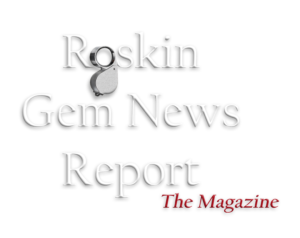Starting October 1, 2025, GIT–the Gem and Jewelry Institute of Thailand’s gem testing laboratory–will be updating the way it words its reports to better line up with CIBJO, the World Jewellery Confederation, and to keep things “clear and transparent.”
Returning to Gemological Science
As we have seen recently with France, and very soon with CIBJO, the GIT will modify its identification field, shifting from: “Laboratory-Grown (name)” to: “Synthetic (name)” … so this means you will now see Synthetic Ruby, Synthetic Diamond, Synthetic Sapphire, etc.
What Stays the Same
For GIT, the terms “Laboratory-Grown” and “Laboratory-Created” aren’t going completely away. They’ll still appear in the comments section of the report, listed as alternative trade terms to “Synthetic.” CIBJO states that “at the upcoming Paris Congress, the commission will propose an amendment to restore exclusive use of ‘synthetic’ for all materials meeting the Blue Book definition, and eliminating the descriptive terms ‘laboratory-grown’ and ‘laboratory-created’ from all CIBJO nomenclature.”
Why the Update?
GIT says that this change will:
- make reports clearer and easier to understand for consumers
- stay aligned with shifting global gemological standards
- keep transparency front and center across the trade
CIBJO will be announcing these and more changes at the Paris Congress, October 27-29, 2025. (See below)

MONDAY, OCTOBER 27 – Wednesday, October 29, 2025 – Paris
How CIBJO Works
CIBJO’s Coloured Stone Commission plays an important role in giving the trade a shared framework. They’ve built standards, terminology, and practical tools that help the business run more smoothly across borders. Most of us rely on that foundation in some way, even if not everyone agrees with every call they make. There are respected gemologists who hold different views, and that’s part of the ongoing conversation in our field. Still, CIBJO remains a well-respected voice, and their aim is clear: to keep the trade as fair and transparent as possible, and to give buyers the information they need to make informed choices. – gr
For more context, here’s how CIBJO itself frames its role – along with the Coloured Stone Commission’s latest Special Report on the use of the term Laboratory-Grown: Updating Synthetic Materials Nomenclature.
â—ˆ
SPECIAL REPORT – COLOURED STONES

President
CIBJO Coloured Stones Commission
“Restoring order during times of volatility and uncertainty, new opal and jade gem guides under development”
from CIBJO
the World Jewellery Confederation
This Special Report covers the work of the Coloured Stone Commission during the course of the past year.
It is technical in nature, and in some respect projects a sense of business as usual during a period that many in our industry have considered volatile and challenging. As has been reported, during 2025 prices for standard coloured stones have softened, although the value of top-tier “investment stones” continues to climb.
But, as a matter of principle, the CIBJO Coloured Stone Commission is price agnostic. That is not to say that, as individuals, we are indifferent to the value of gems. On the contrary many of our members are traders.
But prices are set in the marketplace through the economics of supply and demand. CIBJO’s mission, and that of our commission, is to help ensure that the market operates fairly. For this reason, we developed universal standards, practices, terminology, and tools that help ensure that the coloured stone trade can go about its business in a transparent, fair and responsible manner.
When a purchasing choice is made, the prospective buyer should always be in possession of the information he or she needs to make rational and reasoned decision.
Updating Synthetic Materials Nomenclature
In 2018, following intense lobbying mainly by a well-financed group of synthetic diamond producers, the U.S. Federal Trade Commission updated its Jewelry Guides to allow “laboratory-grown” and “laboratory-created” as descriptive terms for man-made gemstones. In doing so, the FTC commissioners accepted the lobbyist’s contention that many consumers mistakenly understand the term “synthetic” to mean “fake.”
The result of this move was the adoption of “Laboratory-Grown” and “Laboratory-Created” throughout the gemstone trade, spreading confusion. Professionals committed to clear, consistent materials naming have continued to question the logic and transparency of this shift.
We have long taken issue with the FTC terminology. The CIBJO Blue Books define “synthetic” as artificial products matching their natural counterparts in chemical composition, physical properties, and structure.
We have felt that the descriptive terms “laboratory-grown” and “laboratory-created” lack precise definition and could be misapplied to any laboratory-produced substance, including glass or novel composites with no natural equivalent.
Furthermore, these materials are manufactured in industrial facilities – not research laboratories – making the terms misleading.
When the FTC-approved terms emerged, the Coloured Stone Commission added a note to the Blue Book definition of “synthetic,” emphasising that “synthetic” remains synonymous with “laboratory-created,” and “laboratory-grown.” Additionally, a caveat allows national associations to use only “synthetic” if local languages cannot directly translate the other phrases.
After extensive review, the Coloured Stone Commission has concluded that the introduction of the ill-defined FTC terminology ultimately undermined transparency across the supply chain, as well as for consumers. To remedy this, at the upcoming Paris Congress the commission will propose an amendment to restore exclusive use of “synthetic” for all materials meeting the Blue Book definition, and eliminating the descriptive terms “laboratory-grown” and “laboratory-created” from all CIBJO nomenclature.
Tap here to read the full report from CIBJO’s Coloured Stone Commission













